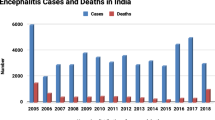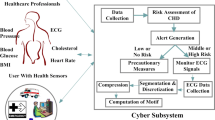Abstract
Generalized Anxiety Disorder (GAD) is a psychological disorder caused by high stress from daily life activities. It causes severe health issues, such as sore muscles, low concentration, fatigue, and sleep deprivation. The less availability of predictive solutions specifically for individuals suffering from GAD can become an imperative reason for health and psychological adversity. The proposed solution aims to monitor health, behavioral and environmental parameters of the individual to predict health adversity caused by GAD. Initially, Weighted-Naïve Bayes (W-NB) classifier is utilized to predict irregular health events by classifying the captured data at the fog layer. The proposed two-phased decision-making process helps to optimize the distribution of required medical services by determining the scale of vulnerability. Furthermore, the utility of the framework is increased by calculating health vulnerability index using Adaptive Neuro-Fuzzy Inference System-Genetic Algorithm (ANFIS-GA) on the cloud. The presented work addresses the concerns in terms of efficient monitoring of anomalies followed by time sensitive two-phased alert generation procedure. To approve the performance of irregular event identification and health severity prediction, the framework has been conveyed in a living room for 30 days in which almost 15 individuals by the age of 68 to 78 years have been continuously monitored. The calculated outcomes represent the monitoring efficiency of the proposed framework over the policies of manual monitoring.











Similar content being viewed by others
Notes
References
James, S.L., Abate, D., Abate, K.H., Abay, S.M., Abbafati, C., Abbasi, N., and Abdollahpour, I., Global, regional, and national incidence, prevalence, and years lived with disability for 354 diseases and injuries for 195 countries and territories, 1990–2017: A systematic analysis for the global burden of disease study. The Lancet 392 (10159):1789–1858, 2018. https://doi.org/10.1016/S0140-6736(18)32279-7.
World Health Organization: Depression and other common mental disorders: global health estimates (No. WHO/MSD/MER/2017.2). World Health Organization, 2017
Leonard, K., and Abramovitch, A., Cognitive functions in young adults with generalized anxiety disorder. European Psychiatry. 1:1–7, 2019. https://doi.org/10.1016/j.eurpsy.2018.10.008.
American Psychiatric Association: Diagnostic and statistical manual of mental disorders (DSM-5). American Psychiatric Pub, 2013
Sood, S. K., and Mahajan, I., A fog-based healthcare framework for chikungunya. IEEE Internet of Things Journal 5(2):794–801, 2017. https://doi.org/10.1109/JIOT.2017.2768407.
Gia, T.N., Jiang, M., Rahmani, A.M., Westerlund, T., Liljeberg, P., and Tenhunen, H.: Fog computing in healthcare internet of things: A case study on ecg feature extraction. In: 2015 IEEE international conference on computer and information technology; ubiquitous computing and communications; dependable, autonomic and secure computing; pervasive intelligence and computing (pp. 356–363). IEEE. https://doi.org/10.1109/CIT/IUCC/DASC/PICOM.2015.51, 2015
Gia, T. N., Jiang, M., Rahmani, A. M., Westerlund, T., Mankodiya, K., Liljeberg, P., and Tenhunen, H.: Fog computing in body sensor networks An energy efficient approach. In: Proc. IEEE int. body sensor netw. conf. (BSN) (pp. 1–7), 2015
Gia, T. N., Jiang, M., Rahmani, A. M., Westerlund, T., Mankodiya, K., Liljeberg, P., and Tenhunen, H.: Fog computing in body sensor networks: An energy efficient approach. In: Proc. IEEE int. body sensor netw. conf. (BSN) (pp. 1-7), 2015
Rahmani, A. M., Gia, T. N., Negash, B., Anzanpour, A., Azimi, I., Jiang, M., and Liljeberg, P., Exploiting smart e-Health gateways at the edge of healthcare Internet-of-Things A fog computing approach. Futur. Gener. Comput. Syst. 78:641–658, 2018. https://doi.org/10.1016/j.future.2017.02.014.
Negash, B., Gia, T. N., Anzanpour, A., Azimi, I., Jiang, M., Westerlund, T., and Tenhunen, H.: Leveraging fog computing for healthcare IoT. In: Fog computing in the internet of things. https://doi.org/10.1007/978-3-319-57639-8, pp. 145–169. Springer, Cham, 2018.
Fratu, O., Pena, C., Craciunescu, R., and Halunga, S.: Fog computing system for monitoring Mild Dementia and COPD patients-Romanian case study. In: 2015 12th international conference on telecommunication in modern satellite, cable and broadcasting services (TELSIKS) (pp. 123–128). IEEE. https://doi.org/10.1109/TELSKS.2015.7357752, 2015
Fang, S., Da Xu, L., Zhu, Y., Ahati, J., Pei, H., Yan, J., and Liu, Z., An integrated system for regional environmental monitoring and management based on internet of things. IEEE Transactions on Industrial Informatics 10(2):1596–1605, 2014. https://doi.org/10.1109/TII.2014.2302638.
Masip-Bruin, X., Marín-Tordera, E., Gómez, A., Barbosa, V., and Alonso, A.: Will it be cloud or will it be fog? f2c, a novel flagship computing paradigm for highly demanding services. In: 2016 future technologies conference (FTC). IEEE., pp. 1129–1136. https://doi.org/10.1109/FTC.2016.7821744, 2016
Xu, B., Xu, L., Cai, H., Jiang, L., Luo, Y., and Gu, Y., The design of an m-Health monitoring system based on a cloud computing platform. Enterprise Information Systems 11(1):17–36, 2017. https://doi.org/10.1080/17517575.2015.1053416.
Rahmani, A. M., Gia, T. N., Negash, B., Anzanpour, A., Azimi, I., Jiang, M., and Liljeberg, P., Exploiting smart e-Health gateways at the edge of healthcare Internet-of-Things A fog computing approach. Futur. Gener. Comput. Syst. 78:641–658, 2018. https://doi.org/10.1016/j.future.2017.02.014.
Clarke, M., Schluter, P., Reinhold, B., and Reinhold, B., Designing robust and reliable timestamps for remote patient monitoring. IEEE journal of biomedical and health informatics 19(5):1718–1723, 2014. https://doi.org/10.1109/JBHI.2014.2343632.
Lauría, E. J., and Duchessi, P.J., A Bayesian belief network for IT implementation decision support. Decision Support Systems 42(3):1573–1588, 2006. https://doi.org/10.1016/j.dss.2006.01.003.
Jang, J. S., ANFIS: Adaptive-network-based fuzzy inference system. IEEE Transactions on Systems, Man, and Cybernetics 23(3):665–685, 1993. https://doi.org/10.1109/21.256541.
Nedjah, N., and de Macedo Mourelle, L., Fuzzy systems engineering: theory and practice (Vol. 181). Springer Science & Business Media 181:2005, 2005.
Holland, J. H.: Adaptation in natural and artificial systems: An introductory analysis with applications to biology, control, and artificial intelligence. MIT press, 1992
Karumbaya, A., and Satheesh, G., Iot empowered real time environment monitoring system. International Journal of Computer Applications 129(5):30–32, 2015. https://doi.org/10.5120/ijca2015906917.
UN, “World Population Aging 2017”, 2017
Fayyad, U, and Irani, K.: Multi-interval discretization of continuous-valued attributes for classification learning. In: Proceedings of the 13th international joint conference on artificial intelligence, pp. 1022–1027, 1993
Facts & Statistics, Anxiety and Depression Association of America, https://adaa.org/about-adaa/press-room/facts-statistics, Accessed on 26 April, 2019
Lenze, E. J., and Wetherell, J. L., A lifespan view of anxiety disorders. Dialogues in clinical neuroscience 13(4):381–399, 2011.
Amazon Cloud Services. https://aws.amazon.com/ec2/. Accessed on 24 February 2019
IBM SPSS Statistics Software. http://www01.ibm.com/software/analytics/spss/. Accessed on 20 March 2019
Michal, M., Wiltink, J., Till, Y., Wild, P. S., Münzel, T., Blankenberg, S., and Beutel, M.E., Type-D personality and depersonalization are associated with suicidal ideation in the German general population aged 35–74: results from the Gutenberg Heart Study. Journal of affective disorders 125(1-3):227–233, 2010. https://doi.org/10.1016/j.jad.2010.02.108.
Culpepper, L., Generalized anxiety disorder and medical illness. The Journal of clinical psychiatry 70(2):20–24, 2009. https://doi.org/10.4088/jcp.s.7002.04.
Wittchen, H. U., Generalized anxiety disorder: Prevalence, burden, and cost to society. Depression and anxiety 16(4):162–171, 2002. https://doi.org/10.1002/da.10065.
Ding, G., Guo, Y., Zhou, J., and Gao, Y., Large-scale cross-modality search via collective matrix factorization hashing. IEEE Trans. Image Process. 25(11):5427–5440, 2016. https://doi.org/10.1109/TIP.2016.2607421.
Lin, J., Keogh, E., Wei, L., and Lonardi, S., Experiencing SAX: a novel symbolic representation of time series. Data Mining and Knowledge Discovery 15(2):107–144, 2007. https://doi.org/10.1007/s10618-007-0064-z.
Zhao, S., Yao, H., Gao, Y., Ji, R., and Ding, G., Continuous probability distribution prediction of image emotions via multitask shared sparse regression. IEEE Transactions on Multimedia 19(3):632–645, 2016. https://doi.org/10.1109/TMM.2016.2617741.
Ayers, C. R., Sorrell, J. T., Thorp, S. R., and Wetherell, J. L., Evidence-based psychological treatments for late-life anxiety. Psychology and Aging 22(1):8–17, 2007. https://doi.org/10.1037/0882-7974.22.1.8.
Montgomery, S. A., and Asberg, M. A. R. I. E., A new depression scale designed to be sensitive to change. The British Journal of Psychiatry 134(4):382–389, 1979. https://doi.org/10.1192/bjp.134.4.382.
Alexopoulos, G. S., Abrams, R. C., Young, R. C., and Shamoian, C. A., Cornell scale for depression in dementia. Biological psychiatry 23(3):271–284, 1988.
Beck, A. T., Steer, R. A., and Brown, G. K., Beck depression inventory-II. San Antonio 78(2):490–498, 1996.
Sheikh, J. I., and Yesavage, J. A.: Geriatric depression scale (GDS): Recent evidence and development of a shorter version. In: Brink, T L (Ed.) Clinical gerontology: A guide to assessment and intervention, pp. 165–73. The Haworth Press , New York, 1986.
Beck, A. T., and Steer, R.A.: BAI: Beck anxiety inventory. Psychological Corporation, 1993
Hamilton, M. A. X., The assessment of anxiety states by rating. British journal of medical psychology 32(1): 50–55, 1959.
Williams, J. B., A structured interview guide for the Hamilton Depression Rating Scale. Archives of general psychiatry 45(8):742–747, 1988. https://doi.org/10.1001/archpsyc.1988.01800320058007.
UCI dataset. https://archive.ics.uci.edu/ml/datasets/. Accessed on 17 February 2019
US EPA dataset. https://aqs.epa.gov/aqsweb/airdata/downloadfiles.html. Accessed on 10 February 2019
Kaye, J., and Zitzelberger, T.: Overview of healthcare, disease, and disability. In: Pervasive computing in healthcare (pp. 29–46). CRC Press, 2006
Lenze, E. J., Mulsant, B. H., Shear, M. K., et al., Comorbidity of depression and anxiety disorders in later life. Depress Anxiety 14:86–93, 2001.
Schoevers, R. A., Beekman, A. T., Deeg, D. J., et al., Comorbidity and risk patterns of depression, generalised anxiety disorder and mixed anxiety-depression in later life: results from the AMSTEL study. Int. J. Geriatr. Psychiatry 18:994–1001, 2003.
UCI dataset. https://archive.ics.uci.edu/ml/datasets/Heart. Accessed on 17 February 2019
UCI dataset. https://archive.ics.uci.edu/ml/datasets/ICU. Accessed on 19 February 2019
Suglia, S. F., Duarte, C. S., and Sandel, M. T., Housing quality, housing instability, and maternal mental health. J. Urban Health 88(6):1105–1116, 2011.
Author information
Authors and Affiliations
Corresponding author
Ethics declarations
Conflict of interests
Authors declare that they have no conflict of interest.
Additional information
Ethical approval
All procedures performed in studies involving human participants were in accordance with the ethical standards of the institutional and/or national research committee and with the 1964 Helsinki declaration and its later amendments or comparable ethical standards.
Publisher’s Note
Springer Nature remains neutral with regard to jurisdictional claims in published maps and institutional affiliations.
This article is part of the Topical Collection on Precision Medicine with Big Data
Guest Editors: Chen Wang, Shiguo Zhou and Xueying Zhang
Rights and permissions
About this article
Cite this article
Manocha, A., Singh, R. & Bhatia, M. Cognitive Intelligence Assisted Fog-Cloud Architecture for Generalized Anxiety Disorder (GAD) Prediction. J Med Syst 44, 7 (2020). https://doi.org/10.1007/s10916-019-1495-y
Received:
Accepted:
Published:
DOI: https://doi.org/10.1007/s10916-019-1495-y




